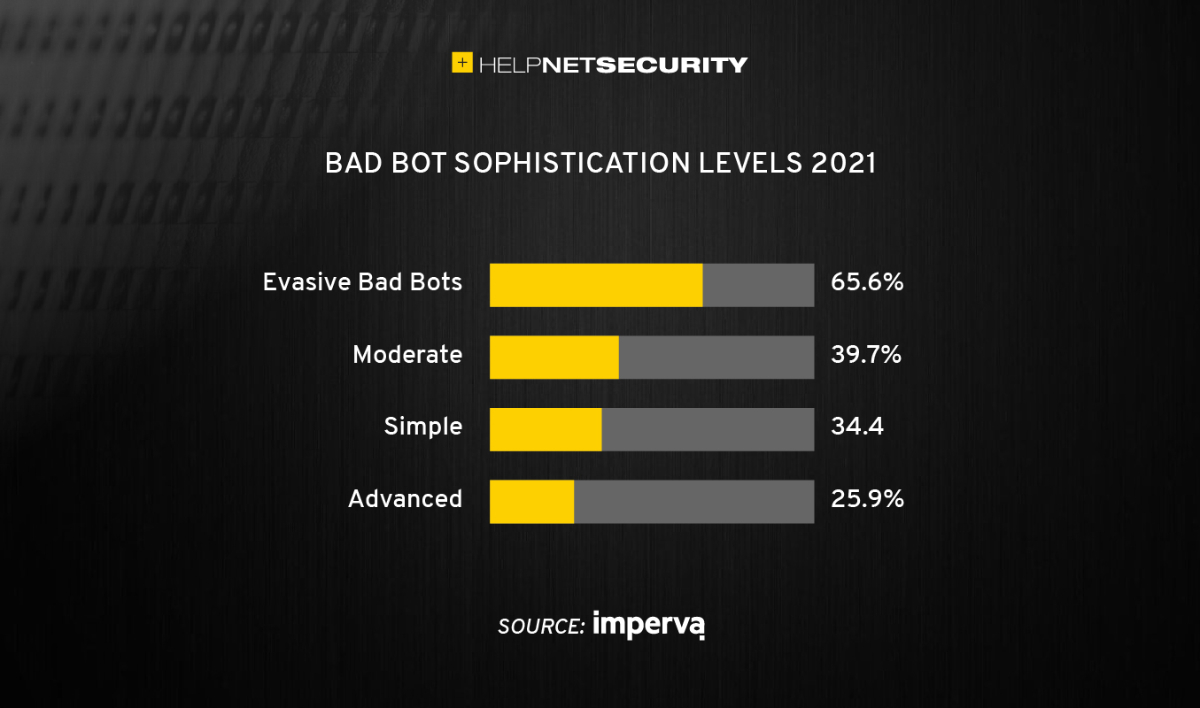Record level of bad bot traffic contributing to rise of online fraud
Bad bots, software applications that run automated tasks with malicious intent, accounted for a record-setting 27.7% of all global website traffic in 2021, up from 25.6% in 2020, an Imperva report reveals. The three most common bot attacks were account takeover (ATO), content or price scraping, and scalping to obtain limited-availability items.

Bad bots are often the first indicator of online fraud and represent a risk to digital businesses, as well as their customers. In 2021, evasive bad bots — a grouping of moderate and advanced bad bots that elude standard security defenses — made up 65.6% of all bad bot traffic. This breed of bot uses the latest evasion techniques, including cycling through random IPs, entering through anonymous proxies, changing identities, and mimicking human behavior to evade detection.
Bad bots enable high-speed abuse, misuse, and attacks on websites, mobile apps, and APIs. Successful attacks can lead to the theft of personal information, credit card data, and loyalty points. For organizations, automated abuse and online fraud contributes to non-compliance with data privacy and transaction regulations. Bad bot traffic is rising at a time when organizations are investing in improving customer experiences online. It’s resulted in more digital services, new online functionality, and the development of expansive API ecosystems. Unfortunately, this array of new endpoints is a ripe target for automated attacks by bad bot operators.
“Businesses cannot overlook the impact of malicious bot activity as it is contributing to more account compromise, higher infrastructure and support costs, customer churn, and degraded online services,” says Ryan Windham, VP, Application Security, Imperva. “With automated fraud growing in intensity and complexity, advanced bot protection is essential for preventing the growing threat digital businesses and consumers face from bad bots.”
Key findings
- Account takeover increased 148% in 2021: In 2021, 64.1% of ATO attacks used an advanced bad bot. Financial Services was the most targeted industry (34.6%), followed by Travel (23.2%). The United States was the leading origin country of ATO attacks (54%) in 2021. The implications of account takeover are extensive; successful attacks lock customers out of their account, while fraudsters gain access to sensitive information that can be stolen and abused. For businesses, ATO contributes to revenue loss, risk of non-compliance with data privacy regulations, and tarnished reputations.
- Travel, retail, and financial services targeted by bad bots: The volume of attacks originating from sophisticated bad bots was most notable across Travel (34.2%), Retail (33.8%), and Financial Services (8.8%) in 2021. These industries remain a prime target because of the valuable personal data they store behind user login portals on their websites and mobile apps.
- Proportion of bad bot traffic varies by country: In 2021, Germany (39.6%), Singapore (39.1%), and Canada (30.2%) experienced the highest volumes of bad bot traffic, while the United States (29.1%) and United Kingdom (29.7%) were also higher than the global average (27.7%) of bad bot traffic.
- 35.6% of bad bots hide as mobile web browsers: Mobile user agents were a popular disguise for bad bot traffic in 2021, accounting for more than one-third of all internet traffic, increasing from 28.1% in 2020. Mobile Safari was a popular agent in 2021 because bots exploited the browser’s improved user privacy settings to mask their behavior, making them harder to detect.
The research concludes that no industry was immune to bad bot activity in 2021. While examples of bots hoarding popular gaming consoles or clogging vaccine appointment scheduling sites made headlines in 2021, any level of bot traffic on a website can cause significant downtime, degrade performance, and reduce service reliability.